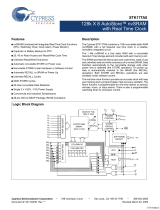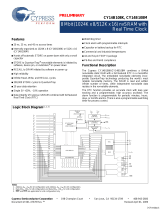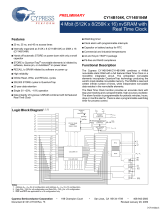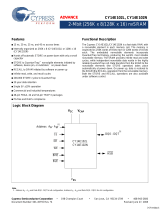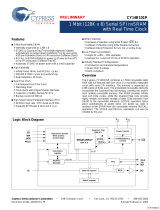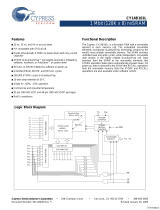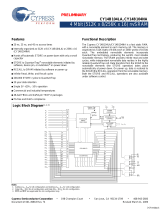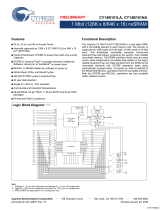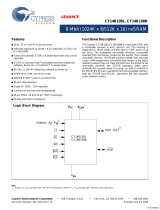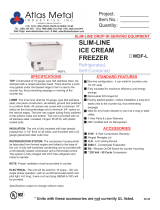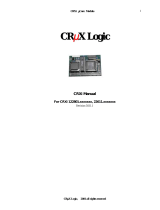Page is loading ...

CY14B101K
1 Mbit (128K x 8) nvSRAM With Real Time Clock
Cypress Semiconductor Corporation • 198 Champion Court • San Jose, CA 95134-1709 • 408-943-2600
Document Number: 001-06401 Rev. *I Revised February 24, 2009
Features
■ 25 ns, 35 ns, and 45 ns access times
■ Pin compatible with STK17TA8
■ Data integrity of Cypress nvSRAM combined with full featured
Real Time Clock (RTC)
❐ Low power, 350 nA RTC current
❐ Capacitor or battery backup for RTC
■ Watchdog timer
■ Clock alarm with programmable interrupts
■ Hands off automatic STORE on power down with only a small
capacitor
■ STORE to QuantumTrap™ initiated by software, device pin, or
on power down
■ RECALL to SRAM initiated by software or on power up
■ Infinite READ, WRITE, and RECALL cycles
■ High reliability
❐ Endurance to 200K cycles
❐ Data retention: 20 years at 55°C
■ Single 3V operation with tolerance of +20%, –10%
■ Commercial and industrial temperature
■ 48-Pin SSOP package (ROHS compliant)
Functional Description
The Cypress CY14B101K combines a 1 Mbit nonvolatile static
RAM with a full featured real time clock in a monolithic integrated
circuit. The embedded nonvolatile elements incorporate
QuantumTrap technology producing the world’s most reliable
nonvolatile memory. The SRAM is read and written an infinite
number of times, while independent, nonvolatile data resides in
the nonvolatile elements.
The Real Time Clock function provides an accurate clock with
leap year tracking and a programmable high accuracy oscillator.
The alarm function is programmable for one time alarm or
periodic seconds, minutes, hours, or days. There is also a
programmable watchdog timer for process control.
STORE/
RECALL
CONTROL
POWER
CONTROL
SOFTWARE
DETECT
STATIC RAM
ARRAY
1024 X 1024
QuantumTrap
1024 x 1024
STORE
RECALL
COLUMN IO
COLUMN DEC
ROW DECODER
INPUT BUFFERS
OE
CE
WE
HSB
V
CC
V
CAP
A
15
- A
0
A
0
A
1
A
2
A
3
A
4
A
10
A
11
A
5
A
6
A
7
A
8
A
9
A
12
A
13
A
14
A
15
A
16
DQ
0
DQ
1
DQ
2
DQ
3
DQ
4
DQ
5
DQ
6
DQ
7
RTC
MUX
A
16
- A
0
x
1
x
2
INT
V
RTCbat
V
RTCcap
Logic Block Diagram
[+] Feedback

CY14B101K
Document Number: 001-06401 Rev. *I Page 2 of 28
Pin Configurations
Figure 1. 48-Pin SSOP
Table 1. Pin Definitions
Pin Name Alt IO Type Description
A
0
– A
16
Input Address Inputs. Used to select one of the 131,072 bytes of the nvSRAM.
DQ0 – DQ7 Input Output Bidirectional Data IO Lines. Used as input or output lines depending on operation
NC No Connect No Connects. This pin is not connected to the die
WE
W
Input Write Enable Input, Active LOW. When the chip is enabled and WE is LOW, data on the IO pins
is written to the specific address location.
CE
E
Input Chip Enable Input, Active LOW. When LOW, selects the chip. When HIGH, deselects the chip.
OE
G
Input Output Enable, Active LOW. The active low OE input enables the data output buffers during
READ cycles. Deasserting OE
high causes the IO pins to tri-state.
X
1
Output Crystal Connection Drives crystal on start up.
X
2
Input Crystal Connection for 32.768 kHz crystal.
V
RTCcap
Power Supply Capacitor Supplied Backup RTC Supply Voltage. (Left unconnected if V
RTCbat
is used)
V
RTCbat
Power Supply Battery Supplied Backup RTC Supply Voltage. (Left unconnected if V
RTCcap
is used)
INT Output Interrupt Output. Program to respond to the clock alarm, the watchdog timer, and the power
monitor. Programmable to either active HIGH (push or pull) or LOW (open drain).
V
SS
Ground Ground for the Device. Must be connected to ground of the system.
V
CC
Power Supply Power Supply Inputs to the Device.
HSB
Input Output Hardware Store Busy. When LOW this output indicates a Hardware Store is in progress. When
pulled LOW external to the chip it initiates a nonvolatile STORE operation. A weak internal pull up
resistor keeps this pin HIGH if not connected (connection optional).
V
CAP
Power Supply AutoStore™ Capacitor. Supplies power to nvSRAM during power loss to store data from SRAM
to nonvolatile elements.
V
CAP
A
16
A
14
A
12
A
7
A
6
A
5
A
4
V
CC
A
15
HSB
WE
A
13
A
8
A
9
A
11
OE
A
10
DQ
DQ7
6
DQ5
CE
DQ4
DQ3
1
2
3
4
5
6
7
8
9
10
11
12
13
14
15
16
17
18
19
20
21
22
23
24
48
47
46
45
44
43
42
41
40
39
38
37
36
35
34
33
32
31
30
29
28
27
26
25
INT
NC
NC
NC
V
SS
NC
DQ0
A
3
A
2
A
1
A
0
DQ1
DQ2
NC
NC
NC
NC
V
SS
NC
V
CC
48-SSOP
Top View
(Not To Scale)
V
RTCbat
x
1
x
2
V
RTCcap
[+] Feedback

CY14B101K
Document Number: 001-06401 Rev. *I Page 3 of 28
Device Operation
The CY14B101K nvSRAM consists of two functional compo-
nents paired in the same physical cell. The components are
SRAM memory cell and a nonvolatile QuantumTrap cell. The
SRAM memory cell operates as a standard fast static RAM. Data
in the SRAM is transferred to the nonvolatile cell (the STORE
operation), or from the nonvolatile cell to SRAM (the RECALL
operation). Using this unique architecture, all cells are stored and
recalled in parallel. During the STORE and RECALL operations,
SRAM READ and WRITE operations are inhibited. The
CY14B101K suppots infinite reads and writes similar to a typical
SRAM. In addition, it provides infinite RECALL operations from
the nonvolatile cells and up to 200K STORE operations.
See the “Truth Table For SRAM Operations” on page 22 for a
complete description of read and write modes.
SRAM READ
The CY14B101K performs a READ cycle whenever CE and OE
are LOW while WE and HSB are HIGH. The address specified
on pins A
0-16
determines which of the 131,072 data bytes are
accessed. When the READ is initiated by an address transition,
the outputs are valid after a delay of t
AA
(see Figure 8 on page
17). If the READ is initiated by CE
or OE, the outputs are valid at
t
ACE
or at t
DOE
, whichever is later (see Figure 9 on page 17). The
data outputs repeatedly respond to address changes within the
t
AA
access time without the need for transitions on any control
input pins. This remains valid until another address change or
until CE or OE is brought HIGH, or WE or HSB is brought LOW.
SRAM WRITE
A WRITE cycle is performed whenever CE and WE are LOW and
HSB
is HIGH. The address inputs must be stable before entering
the WRITE cycle and must remain stable until either CE
or WE
go HIGH at the end of the cycle. The data on the common IO pins
DQ
0–7
is written into the memory if the data is valid t
SD
before
the end of a WE
controlled WRITE or before the end of an CE
controlled WRITE. Keep OE HIGH during the entire WRITE cycle
to avoid data bus contention on common IO lines. If OE
is left
LOW, internal circuitry turns off the output buffers t
HZWE
after WE
goes LOW.
AutoStore
®
Operation
The CY14B101K stores data to nvSRAM using one of three
storage operations:
1. Hardware Store activated by HSB
2. Software Store activated by an address sequence
3. AutoStore on device power down
AutoStore operation is a unique feature of QuantumTrap
technology and is enabled by default on the CY14B101K.
During normal operations, the device draws current from V
CC
to
charge a capacitor connected to the V
CAP
pin. This stored
charge is used by the chip to perform a single STORE operation.
If the voltage on the V
CC
pin drops below V
SWITCH
, the part
automatically disconnects the V
CAP
pin from V
CC
. A STORE
operation is initiated with power provided by the V
CAP
capacitor.
Figure 2 shows the proper connection of the storage capacitor
(V
CAP
) for automatic store operation. Refer to DC Electrical
Characteristics on page 15 for the size of the V
CAP
. The voltage
on the V
CAP
pin is driven to 5V
by a charge pump internal to the
chip. A pull up should be placed on WE
to hold it inactive during
power up. This pull up is only effective if the WE
signal is tri-state
during power up. Many MPUs tri-state their controls on power up.
Verify this when using the pull up. When the nvSRAM comes out
of power-on-recall, the MPU must be active or the WE
held
inactive until the MPU comes out of reset.
To reduce unnecessary nonvolatile stores, AutoStore and
Hardware Store operations are ignored unless at least one
WRITE operation takes place since the most recent STORE or
RECALL cycle. Software initiated STORE cycles are performed
regardless of whether a WRITE operation took place. Monitor the
HSB signal by the system to detect if an AutoStore cycle is in
progress.
Hardware STORE (HSB) Operation
The CY14B101K provides the HSB pin for controlling and
acknowledging the STORE operations. Use the HSB
pin to
request a hardware STORE cycle. When the HSB
pin is driven
LOW, the CY14B101K conditionally initiates a STORE operation
after t
DELAY
. An actual STORE cycle only begins if a WRITE to
the SRAM has taken place since the last STORE or RECALL
cycle. The HSB
pin also acts as an open drain driver that is inter-
nally driven LOW to indicate a busy condition while the STORE
(initiated by any means) is in progress. This pin is externally
pulled up if it is used to drive other inputs.
Figure 2. AutoStore Mode
V
CC
V
CC
V
CAP
V
CAP
WE
10k Ohm
0.1 F
U
[+] Feedback

CY14B101K
Document Number: 001-06401 Rev. *I Page 4 of 28
SRAM READ and WRITE operations that are in progress when
HSB
is driven LOW by any means are given time to complete
before the STORE operation is initiated. After HSB
goes LOW,
the CY14B101K continues SRAM operations for t
DELAY
. During
t
DELAY
, multiple SRAM READ operations take place. If a WRITE
is in progress when HSB
is pulled LOW, it is allowed a time,
t
DELAY
, to complete. However, any SRAM WRITE cycles
requested after HSB
goes LOW are inhibited until HSB returns
HIGH.
During any STORE operation, regardless of how it is initiated,
the CY14B101K continues to drive the HSB
pin LOW, releasing
it only when the STORE is complete. After completing the
STORE operation, the CY14B101K remains disabled until the
HSB
pin returns HIGH. Leave the HSB unconnected if it is not
used.
Hardware RECALL (Power Up)
During power up or after any low power condition
(V
CC
<V
SWITCH
), an internal RECALL request is latched. When
V
CC
again exceeds the sense voltage of V
SWITCH
, a RECALL
cycle automatically initiates and takes t
HRECALL
to complete.
Software STORE
Data is transferred from the SRAM to the nonvolatile memory by
a software address sequence. The CY14B101K software
STORE cycle is initiated by executing sequential CE controlled
READ cycles from six specific address locations in exact order.
During the STORE cycle, an erase of the previous nonvolatile
data is first performed followed by a program of the nonvolatile
elements. After a STORE cycle is initiated, further READs and
WRITEs are inhibited until the cycle is completed.
Because a sequence of READs from specific addresses is used
for STORE initiation, it is important that no other READ or WRITE
accesses intervene in the sequence. If it intervenes, the
sequence is aborted and no STORE or RECALL takes place.
To initiate the software STORE cycle, the following READ
sequence are performed:
1. Read Address 0x4E38 Valid READ
2. Read Address 0xB1C7 Valid READ
3. Read Address 0x83E0 Valid READ
4. Read Address 0x7C1F Valid READ
5. Read Address 0x703F Valid READ
6. Read Address 0x8FC0 Initiate STORE cycle
The software sequence is clocked with CE
controlled READs or
OE
controlled READs. After the sixth address in the sequence is
entered, the STORE cycle commences and the chip is disabled.
It is important to use read cycles and not write cycles in the
sequence, although it is not necessary that OE
be LOW for a
valid sequence. After the t
STORE
cycle time is fulfilled, the SRAM
is activated again for READ and WRITE operation.
Software RECALL
Data is transferred from the nonvolatile memory to the SRAM by
a software address sequence. A software RECALL cycle is
initiated with a sequence of READ operations in a manner similar
to the software STORE initiation. To initiate the RECALL cycle,
the following sequence of CE
controlled READ operations are
performed:
1. Read Address 0x4E38 Valid READ
2. Read Address 0xB1C7 Valid READ
3. Read Address 0x83E0 Valid READ
4. Read Address 0x7C1F Valid READ
5. Read Address 0x703F Valid READ
6. Read Address 0x4C63 Initiate RECALL Cycle
Internally, RECALL is a two step procedure. First, the SRAM data
is cleared and then the nonvolatile information is transferred into
the SRAM cells. After the t
RECALL
cycle time, the SRAM is again
ready for READ and WRITE operations. The RECALL operation
does not alter the data in the nonvolatile elements.
Data Protection
The CY14B101K protects data from corruption during low
voltage conditions by inhibiting all externally initiated STORE
and WRITE operations. The low voltage condition is detected
when V
CC
is less than V
SWITCH
. If the CY14B101K is in a WRITE
mode (both CE
and WE LOW) at power up, after a RECALL or
after a STORE, the WRITE is inhibited until a negative transition
on CE
or WE is detected. This protects against inadvertent writes
during power up or brownout conditions.
Noise Considerations
The CY14B101K is a high speed memory and must have a high
frequency bypass capacitor of approximately 0.1 µF connected
between V
CC
and V
SS
, using leads and traces that are as short
as possible. As with all high speed CMOS ICs, careful routing of
power, ground, and signals reduce circuit noise.
[+] Feedback

CY14B101K
Document Number: 001-06401 Rev. *I Page 5 of 28
Low Average Active Power
CMOS technology provides the CY14B101K the benefit of
drawing significantly less current when it is cycled at times longer
than 50 ns. Figure 3 shows the relationship between I
CC
and
READ/WRITE Cycle Time. The worst case current consumption
is shown for commercial temperature range, V
CC
= 3.6V, and
chip enable at maximum frequency. Only standby current is
drawn when the chip is disabled.
The overall average current drawn by the CY14B101K depends
on the following items:
■ The duty cycle of chip enable
■ The overall cycle rate for accesses
■ The ratio of READs to WRITEs
■ The operating temperature
■ The V
CC
level
■ IO loading
Best Practices
nvSRAM products have been used effectively for over 15 years.
While ease-of-use is one of the product’s main system values,
experience gained working with hundreds of applications has
resulted in the following suggestions as best practices:
■ The nonvolatile cells in an nvSRAM are programmed on the
test floor during final test and quality assurance. Incoming
inspection routines at customer or contract manufacturer’s
sites sometimes reprograms these values. Final NV patterns
are typically repeating patterns of AA, 55, 00, FF, A5, or 5A.
The end product’s firmware should not assume that an NV array
is in a set programmed state. Routines that check memory
content values to determine first time system configuration and
cold or warm boot status, must always program a unique NV
pattern (for example, complex 4-byte pattern of 46 E6 49 53
hex or more random bytes) as part of the final system manufac-
turing test to ensure these system routines work consistently.
■ The OSCEN bit in the Calibration register at 0x1FFF8 should
be set to 1 to preserve battery life when the system is in storage
(see Stopping and Starting the Oscillator on page 7).
■ The Vcap value specified in this data sheet includes a minimum
and a maximum value size. The best practice is to meet this
requirement and not exceed the maximum Vcap value because
the higher inrush currents may reduce the reliability of the
internal pass transistor. Customers who want to use a larger
Vcap value to make sure there is extra store charge should
discuss their Vcap size selection with Cypress.
Figure 3. Current versus Cycle Time
[+] Feedback

CY14B101K
Document Number: 001-06401 Rev. *I Page 6 of 28
Table 2. Mode Selection
CE WE OE
A15 – A0 Mode IO Power
H X X X Not Selected Output High Z Standby
L H L X READ SRAM Output Data Active
L L X X WRITE SRAM Input Data Active
L H L 0x4E38
0xB1C7
0x83E0
0x7C1F
0x703F
0x8FC0
Read SRAM
Read SRAM
Read SRAM
Read SRAM
Read SRAM
Nonvolatile
STORE
Output Data
Output Data
Output Data
Output Data
Output Data
Output High Z
Active I
CC2
[1, 2, 3]
L H L 0x4E38
0xB1C7
0x83E0
0x7C1F
0x703F
0x4C63
Read SRAM
Read SRAM
Read SRAM
Read SRAM
Read SRAM
Nonvolatile
RECALL
Output Data
Output Data
Output Data
Output Data
Output Data
Output High Z
Active
[1, 2, 3]
Notes
1. The six consecutive address locations are in the order listed. WE
is HIGH during all six cycles to enable a nonvolatile cycle.
2. While there are 17 address lines on the CY14B101K, only the lower 16 lines are used to control software modes.
3. O state depends on the state of OE
. The IO table shown is based on OE Low.
[+] Feedback

CY14B101K
Document Number: 001-06401 Rev. *I Page 7 of 28
Real Time Clock Operation
nvTIME Operation
The CY14B101K offers internal registers that contain clock,
alarm, watchdog, interrupt, and control functions. RTC registers
use the last 16 address locations of the SRAM. Internal double
buffering of the clock and the clock or timer information registers
prevents accessing transitional internal clock data during a
READ or WRITE operation. Double buffering also circumvents
disrupting normal timing counts or clock accuracy of the internal
clock while accessing clock data. Clock and Alarm Registers
store data in BCD format.
The RTC register addresses for CY14B101K range from
0x1FFF0 to 0x1FFFF. Refer to RTC Register Map[5, 6] on page
11 and Register Map Detail on page 12 for detailed description.
Clock Operations
The clock registers maintain time up to 9,999 years in one
second increments. The user sets the time to any calendar time
and the clock automatically keeps track of days of the week,
month, leap years, and century transitions. There are eight
registers dedicated to the clock functions that are used to set
time with a WRITE cycle and to READ time during a READ cycle.
These registers contain the Time of Day in BCD format. Bits
defined as ‘0’ are currently not used and are reserved for future
use by Cypress.
Reading the Clock
The double buffered RTC register structure reduces the chance
of reading incorrect data from the clock. The user should stop
internal updates to the CY14B101K time keeping registers
before reading clock data, to prevent reading of data in transition.
Stopping the internal register updates does not affect clock
accuracy.
The updating process is stopped by writing a ‘1’ to the read bit
‘R’ (in the flags register at 0x1FFF0), and does not restart until a
‘0’ is written to the read bit. The RTC registers are then read while
the internal clock continues to run. After a ‘0’ is written to the read
bit (‘R’), all CY14B101K registers are simultaneously updated
within 20 ms.
Setting the Clock
Setting the write bit ‘W’ (in the flags register at 0x1FFF0) to a ‘1’
stops updates to the time keeping registers and enables the time
to be set. The correct day, date, and time are then written into
the registers in 24 hour BCD format. The time written is referred
to as the ‘Base Time’. This value is stored in nonvolatile registers
and used in calculation of the current time. Resetting the WRITE
bit to ‘0’ transfers those values to the actual clock counters, after
which the clock resumes normal operation.
Backup Power
The RTC in the CY14B101K is intended for permanently
powered operations. Either the V
RTCcap
or V
RTCbat
pin is
connected depending on whether a capacitor or battery is
chosen for the application. When the primary power, V
CC
, fails
and drops below V
SWITCH
, the device switches to the backup
power supply.
The clock oscillator uses very little current to maximize the
backup time available from the backup source. Regardless of
clock operation with the primary source removed, the data stored
in nvSRAM is secure, as it is stored in the nonvolatile elements
when power was lost.
During backup operation, the CY14B101K consumes a
maximum of 300 nA at 2V. The user should choose capacitor or
battery values according to the application.
Backup time values, based on maximum current specifications,
are shown in the following table. Nominal times are approxi-
mately three times longer.
Using a capacitor has the obvious advantage of recharging the
backup source each time the system is powered up. If a battery
is used, use a 3V lithium; the CY14B101K only sources current
from the battery when the primary power is removed. However,
the battery is not recharged at any time by the CY14B101K. The
battery capacity is chosen for total anticipated cumulative
downtime required over the life of the system.
Stopping and Starting the Oscillator
The OSCEN bit in the calibration register at 0x1FFF8 controls
the enable and disable of the oscillator. This active LOW bit is
nonvolatile and is shipped to customers in the “enabled” (set to
0) state. To preserve the battery life when the system is in
storage, OSCEN bit must be set to ‘1’. This turns off the oscillator
circuit, extending the battery life. If the OSCEN bit goes from
disabled to enabled, it takes approximately 5 seconds (10
seconds maximum) for the oscillator to start.
While system power is off, if the voltage on the backup supply
(V
RTCcap
or V
RTCbat
) falls below their respective minimum level,
the oscillator may fail.The CY14B101K has the ability to detect
oscillator failure when system power is restored. This is recorded
in the OSCF (Oscillator Failed bit) of the Flags register at
address 0x1FFF0. When the device is powered on (V
CC
goes
above V
SWITCH
), the OSCEN bit is checked for “enabled” status.
If the OSCEN bit is enabled and the oscillator is not active within
the first 5 ms, the OSCF bit is set to “1”. The system must check
for this condition and then write ‘0’ to clear the flag. Note that in
addition to setting the OSCF flag bit, the time registers are reset
to the “Base Time” (see “Setting the Clock” on page 7), which is
the value last written to the time keeping registers. The Control
or Calibration registers and the OSCEN bit are not affected by
the “oscillator failed” condition.
The value of OSCF must be reset to ‘0’ when the time registers
are written for the first time. This initializes the state of this bit
which may have become set when the system was first powered
on.
To reset OSCF, set the write bit “W” (in the flags register at
0x1FFF0) to “1” to enable writes to the Flag register. Write a “0”
to the OSCF bit and then reset the write bit to “0” to disable
writes.
Table 3. RTC Backup Time
Capacitor Value Backup Time
0.1F 72 hours
0.47F 14 days
1.0F 30 days
[+] Feedback

CY14B101K
Document Number: 001-06401 Rev. *I Page 8 of 28
Calibrating the Clock
The RTC is driven by a quartz controlled oscillator with a nominal
frequency of 32.768 kHz. Clock accuracy depends on the quality
of the crystal and calibration. The crystal oscillators typically
have an error of +
20ppm to +35ppm. However, CY14B101K
employs a calibration circuit that improves the accuracy to +1/–2
ppm at 25°C. This implies an error of +2.5 seconds to -5 seconds
per month.
The
calibration circuit adds or subtracts counts from the oscillator
divider circuit to achieve this accuracy. The number of pulses that
are suppressed (subtracted, negative calibration) or split (added,
positive calibration) depends upon the value loaded into the five
calibration bits found in Calibration register at 0x1FFF8. The
calibration bits occupy the five lower order bits in the Calibration
register. These bits are set to represent any value between ‘0’
and 31 in binary form. Bit D5 is a sign bit, where a ‘1’ indicates
positive calibration and a ‘0’ indicates negative calibration.
Adding counts speeds the clock up and subtracting counts slows
the clock down. If a binary ‘1’ is loaded into the register, it corre-
sponds to an adjustment of 4.068 or –2.034 ppm offset in oscil-
lator error, depending on the sign.
Calibration occurs within a 64 minute cycle. The first 62 minutes
in the cycle may, once per minute, have one second shortened
by 128 or lengthened by 256 oscillator cycles. If a binary ‘1’ is
loaded into the register, only the first two minutes of the 64
minute cycle is modified. If a binary 6 is loaded, the first 12 are
affected, and so on. Therefore, each calibration step has the
effect of adding 512 or subtracting 256 oscillator cycles for every
125,829,120 actual oscillator cycles, that is, 4.068 or –2.034 ppm
of adjustment per calibration step in the Calibration register.
To determine the required calibration, the CAL bit in the Flags
register (0x1FFF0) must be set to ‘1’. This causes the INT pin to
toggle at a nominal frequency of 512 Hz. Any deviation
measured from the 512 Hz indicates the degree and direction of
the required correction. For example, a reading of 512.01024 Hz
indicates a +20 ppm error. Hence, a decimal value of –10
(001010b) must be loaded into the Calibration register to offset
this error.
Note Setting or changing the Calibration register does not affect
the test output frequency.
To set or clear CAL, set the write bit “W” (in the flags register at
0x1FFF0) to “1” to enable writes to the Flag register. Write a
value to CAL, and then reset the write bit to “0” to disable writes.
Alarm
The alarm function compares user programmed values of alarm
time and date (stored in the registers 0x1FFF1-5) with the corre-
sponding time of day and date values. When a match occurs, the
alarm internal flag (AF) is set and an interrupt is generated on
INT pin if Alarm Interrupt Enable (AIE) bit is set.
There are four alarm match fields - date, hours, minutes, and
seconds. Each of these fields has a match bit that is used to
determine if the field is used in the alarm match logic. Setting the
match bit to ‘0’ indicates that the corresponding field is used in
the match process. Depending on the match bits, the alarm
occurs as specifically as once a month or as frequently as once
every minute. Selecting none of the match bits (all 1s) indicates
that no match is required and therefore, alarm is disabled.
Selecting all match bits (all 0s) causes an exact time and date
match.
There are two ways to detect an alarm event: by reading the AF
flag or monitoring the INT pin. The AF flag in the flags register at
0x1FFF0 indicates that a date or time match has occurred. The
AF bit is set to “1” when a match occurs. Reading the flags or
control register clears the alarm flag bit (and all others). A
hardware interrupt pin may also be used to detect an alarm
event.
Note CY14B101K requires the alarm match bit for seconds
(0x1FFF2 - D7) to be set to ‘0’ for proper operation of Alarm Flag
and Interrupt.
Alarm registers are not nonvolatile and, therefore, need to be
reinitialized by software on power up. To set, clear or enable an
alarm, set the ‘W’ bit (in Flags Register - 0x1FFF0) to ‘1’ to
enable writes to Alarm Registers. After writing the alarm value,
clear the ‘W’ bit back to “0” for the changes to take effect.
Watchdog Timer
The Watchdog Timer is a free running down counter that uses
the 32 Hz clock (31.25 ms) derived from the crystal oscillator.
The oscillator must be running for the watchdog to function. It
begins counting down from the value loaded in the Watchdog
Timer register.
The timer consists of a loadable register and a free running
counter. On power up, the watchdog time out value in register
0x1FFF7 is loaded into the Counter Load register. Counting
begins on power up and restarts from the loadable value any time
the Watchdog Strobe (WDS) bit is set to ‘1’. The counter is
compared to the terminal value of ‘0’. If the counter reaches this
value, it causes an internal flag and an optional interrupt output.
You can prevent the time out interrupt by setting WDS bit to ‘1’
prior to the counter reaching ‘0’. This causes the counter to
reload with the watchdog time out value and to be restarted. As
long as the user sets the WDS bit prior to the counter reaching
the terminal value, the interrupt and WDT flag never occur.
New time out values are written by setting the watchdog write bit
to ‘0’. When the WDW is ‘0’, new writes to the watchdog time out
value bits D5-D0 are enabled to modify the time out value. When
WDW is ‘1’, writes to bits D5-D0 are ignored. The WDW function
enables a user to set the WDS bit without concern that the
watchdog timer value is modified. A logical diagram of the
watchdog timer is shown in Figure 4. Note that setting the
watchdog time out value to ‘0’ disables the watchdog function.
The output of the watchdog timer is the flag bit WDF that is set if
the watchdog is allowed to time out. The flag is set upon a
watchdog time out and cleared when the user reads the Flags or
Control registers. If the watchdog time out occurs, the user also
enables an optional interrupt source to drive the INT pin.
[+] Feedback

CY14B101K
Document Number: 001-06401 Rev. *I Page 9 of 28
Power Monitor
The CY14B101K provides a power management scheme with
power fail interrupt capability. It also controls the internal switch
to backup power for the clock and protects the memory from low
V
CC
access. The power monitor is based on an internal band gap
reference circuit that compares the V
CC
voltage to V
SWITCH
threshold.
As described in the “AutoStore® Operation” on page 3, when
V
SWITCH
is reached as V
CC
decays from power loss, a data store
operation is initiated from SRAM to the nonvolatile elements,
securing the last SRAM data state. Power is also switched from
V
CC
to the backup supply (battery or capacitor) to operate the
RTC oscillator.
When operating from the backup source, read and write opera-
tions to nvSRAM are inhibited and the clock functions are not
available to the user. The clock continues to operate in the
background. The updated clock data is available to the user
t
HRECALL
delay after V
CC
is restored to the device (see
“AutoStore or Power Up RECALL” on page 19).
Interrupts
The CY14B101K has a Flags register, Interrupt register and
Interrupt logic that can signal interrupt to the microcontroller.
There are three potential sources for interrupt: watchdog timer,
power monitor, and alarm timer. Each of these can be individually
enabled to drive the INT pin by appropriate setting in the Interrupt
register (0x1FFF6). In addition, each has an associated flag bit
in the Flags register (0x1FFF0) that the host processor uses to
determine the cause of the interrupt. The INT pin driver has two
bits that specify its behavior when an interrupt occurs.
An Interrupt is raised only if both a flag is raised by one of the
three sources and the respective interrupt enable bit in Interrupts
register is enabled (set to ‘1’). After an interrupt source is active,
two programmable bits, H/L and P/L, determine the behavior of
the output pin driver on INT pin. These two bits are located in the
Interrupt register and can be used to drive level or pulse mode
output from the INT pin. In pulse mode, the pulse width is
internally fixed at approximately 200 ms. This mode is intended
to reset a host microcontroller. In the level mode, the pin goes to
its active polarity until the Flags register is read by the user. This
mode is used as an interrupt to a host microcontroller. The
control bits are summarized in the following section.
Interrupt Register
Watchdog Interrupt Enable - WIE. When set to ‘1’, the
watchdog timer drives the INT pin and an internal flag when a
watchdog time out occurs. When WIE is set to ‘0’, the watchdog
timer only affects the WDF flag in Flags register.
Alarm Interrupt Enable - AIE. When set to ‘1’, the alarm match
drives the INT pin and an internal flag. When AIE is set to ‘0’, the
alarm match only affects the AF flagin Flags register.
Power Fail Interrupt Enable - PFE. When set to ‘1’, the power
fail monitor drives the pin and an internal flag. When PFE is set
to ‘0’, the power fail monitor only affects the PF flag in Flags
register.
High/Low - H/L. When set to a ‘1’, the INT pin is active HIGH
and the driver mode is push pull. The INT pin drives high only
when V
CC
is greater than V
SWITCH
. When set to a ‘0’, the INT pin
is active LOW and the drive mode is open drain. Active LOW
(open drain) is operational even in battery backup mode.
Pulse/Level - P/L. When set to a ‘1’ and an interrupt occurs, the
INT pin is driven for approximately 200 ms. When P/L is set to a
‘0’, the INT pin is driven high or low (determined by H/L) until the
Flags or Control register is read.
When an enabled interrupt source activates the INT pin, an
external host reads the Flags registers to determine the cause.
Remember that all flags are cleared when the register is read. If
the INT pin is programmed for Level mode, then the condition
clears and the INT pin returns to its inactive state. If the pin is
programmed for Pulse mode, then reading the flag also clears
the flag and the pin. The pulse does not complete its specified
duration if the Flags register is read. If the INT pin is used as a
host reset, then the Flags or Control register is not read during a
reset.
Flags Register
The Flag register has three flag bits: WDF, AF, and PF, which can
be used to generate an interrupt. These flags are set by the
watchdog timeout, alarm match, or power fail monitor respec-
tively. The processor can either poll this register or enable inter-
rupts to be informed when a flag is set. These flags are automat-
ically reset once the register is read. The flags register is
automatically loaded with the value 00h on power up (except for
the OSCF bit. See “Stopping and Starting the Oscillator” on
page 7.)
Figure 4. Watchdog Timer Block Diagram
1 Hz
Oscillator
Clock
Divider
Counter
Zero
Compare
WDF
WDS
Load
Register
WDW
D
Q
Q
Watchdog
Register
write to
Watchdog
Register
32 Hz
32,768 KHz
[+] Feedback

CY14B101K
Document Number: 001-06401 Rev. *I Page 10 of 28
Figure 5. Interrupt Block Diagram
Figure 6. RTC Recommended Component Configuration
WDF - Watchdog Timer Flag
WIE - Watchdog Interrupt
PF - Power Fail Flag
PFE - Power Fail Enable
AF - Alarm Flag
AIE - Alarm Interrupt Enable
P/L - Pulse Level
H/L - High/Low
Enable
Watchdog
Timer
Power
Monitor
Clock
Alarm
VINT
WDF
WIE
PF
PFE
AF
AIE
P/L
Pin
Driver
H/L
INT
V
CC
V
SS
C
1
C
2
RF
Y
1
X
1
X
2
A
0
A
1
A
2
A
3
DQ
0
Recommended Values
Y1 = 32.768KHz
RF = 10M Ohm
C1 = 0 (install cap footprint, but leave unloaded)
C2 = 56 pF +
10% (do not vary from this value)
Note
4. Schottky diodes, (V
F
< 0.4V at I
F
=100mA) are recommended at pins A
0
- A
3
and DQ
0
in applications where undershoot exceeds -0.5V. Please see application note
AN49947 for further details.
[+] Feedback

CY14B101K
Document Number: 001-06401 Rev. *I Page 11 of 28
Table 4. RTC Register Map
[5, 6]
Register
BCD Format Data
[5]
Function/Range
D7 D6 D5 D4 D3 D2 D1 D0
0x1FFFF 10s Years Years Years: 00–99
0x1FFFE 0 0 0 10s Months Months Months: 01–12
0x1FFFD 0 0 10s Day of Month Day Of Month Day of Month: 01–31
0x1FFFC 0 0 0 0 0 Day of Week Day of Week: 01–07
0x1FFFB 0 0 10s Hours Hours Hours: 00–23
0x1FFFA 0 10s Minutes Minutes Minutes: 00–59
0x1FFF9 0 10s Seconds Seconds Seconds: 00–59
0x1FFF8 OSCEN
(0)
0 Cal Sign
(0)
Calibration (00000) Calibration Values
[7]
0x1FFF7 WDS (0) WDW (0) WDT (000000) Watchdog
[7]
0x1FFF6 WIE (0) AIE (0) PFE (0) 0 H/L (1) P/L (0) 0 0 Interrupts
[7]
0x1FFF5 M (1) 0 10s Alarm Date Alarm Day Alarm, Day of Month: 01–31
0x1FFF4 M (1) 0 10s Alarm Hours Alarm Hours Alarm, Hours: 00–23
0x1FFF3 M (1) 10 Alarm Minutes Alarm Minutes Alarm, Minutes: 00–59
0x1FFF2 M (1) 10 Alarm Seconds Alarm, Seconds Alarm, Seconds: 00–59
0x1FFF1 10s Centuries Centuries Centuries: 00–99
0x1FFF0 WDF AF PF OSCF 0 CAL (0) W (0) R (0) Flags
[7]
Notes
5. ( ) designates values shipped from the factory.
6. The unused bits of RTC registers are reserved for future use and should be set to ‘0’.
7. Is a binary value, not a BCD value.
[+] Feedback

CY14B101K
Document Number: 001-06401 Rev. *I Page 12 of 28
Table 5. Register Map Detail
0x1FFFF
Time Keeping - Years
D7 D6 D5 D4 D3 D2 D1 D0
10s Years Years
Contains the lower two BCD digits of the year. Lower nibble (four bits) contains the value for years; upper nibble (four
bits) contains the value for 10s of years. Each nibble operates from 0 to 9. The range for the register is 0–99.
0x1FFFE
Time Keeping - Months
D7 D6 D5 D4 D3 D2 D1 D0
0 0 0 10s Month Months
Contains the BCD digits of the month. Lower nibble (four bits) contains the lower digit and operates from 0 to 9; upper
nibble (one bit) contains the upper digit and operates from 0 to 1. The range for the register is 1–12.
0x1FFFD
Time Keeping - Date
D7 D6 D5 D4 D3 D2 D1 D0
0 0 10s Day of Month Day of Month
Contains the BCD digits for the date of the month. Lower nibble (four bits) contains the lower digit and operates from 0
to 9; upper nibble (two bits) contains the 10s digit and operates from 0 to 3. The range for the register is 1–31. Leap
years are automatically adjusted for.
0x1FFFC
Time Keeping - Day
D7 D6 D5 D4 D3 D2 D1 D0
0 0 0 0 0 Day of Week
Lower nibble (three bits) contains a value that correlates to day of the week. Day of the week is a ring counter that counts
from 1 to 7 then returns to 1. The user must assign meaning to the day value, because the day is not integrated with the
date.
0x1FFFB
Time Keeping - Hours
D7 D6 D5 D4 D3 D2 D1 D0
0 0 10s Hours Hours
Contains the BCD value of hours in 24 hour format. Lower nibble (four bits) contains the lower digit and operates from
0 to 9; upper nibble (two bits) contains the upper digit and operates from 0 to 2. The range for the register is 0–23.
0x1FFFA
Time Keeping - Minutes
D7 D6 D5 D4 D3 D2 D1 D0
0 10s Minutes Minutes
Contains the BCD value of minutes. Lower nibble (four bits) contains the lower digit and operates from 0 to 9; upper
nibble (three bits) contains the upper minutes digit and operates from 0 to 5. The range for the register is 0–59.
0x1FFF9
Time Keeping - Seconds
D7 D6 D5 D4 D3 D2 D1 D0
0 10s Seconds Seconds
Contains the BCD value of seconds. Lower nibble (four bits) contains the lower digit and operates from 0 to 9; upper
nibble (three bits) contains the upper digit and operates from 0 to 5. The range for the register is 0–59.
[+] Feedback

CY14B101K
Document Number: 001-06401 Rev. *I Page 13 of 28
0X1FFF8
Calibration/Control
D7 D6 D5 D4 D3 D2 D1 D0
OSCEN 0 Calibration
Sign
Calibration
OSCEN Oscillator Enable. When set to 1, the oscillator is stopped. When set to 0, the oscillator runs. Disabling the oscillator
saves battery or capacitor power during storage.
Calibration
Sign
Determines if the calibration adjustment is applied as an addition (1) to or as a subtraction (0) from the time-base.
Calibration These five bits control the calibration of the clock.
0x1FFF7
WatchDog Timer
D7 D6 D5 D4 D3 D2 D1 D0
WDS WDW WDT
WDS Watchdog Strobe. Setting this bit to 1 reloads and restarts the watchdog timer. Setting the bit to 0 has no effect. The bit
is cleared automatically after the watchdog timer is reset. The WDS bit is write only. Reading it always returns a 0.
WDW Watchdog Write Enable. Setting this bit to 1 disables any WRITE to the watchdog timeout value (D5–D0). This allows
the user to set the watchdog strobe bit without disturbing the timeout value. Setting this bit to 0 allows bits D5–D0 to be
written to the watchdog register when the next write cycle is complete. This function is explained in detail in the “Watchdog
Timer” on page 8.
WDT Watchdog timeout selection. The watchdog timer interval is selected by the 6-bit value in this register. It represents a
multiplier of the 32 Hz count (31.25 ms). The range of timeout value is 31.25 ms (a setting of 1) to 2 seconds (setting of
3 Fh). Setting the watchdog timer register to 0 disables the timer. These bits can be written only if the WDW bit was set
to 0 on a previous cycle.
0x1FFF6
Interrupt Status/Control
D7 D6 D5 D4 D3 D2 D1 D0
WIE AIE PFIE 0 H/L P/L 0 0
WIE Watchdog Interrupt Enable. When set to 1 and a watchdog timeout occurs, the watchdog timer drives the INT pin and
the WDF flag. When set to 0, the watchdog timeout affects only the WDF flag.
AIE Alarm Interrupt Enable. When set to 1, the alarm match drives the INT pin and the AF flag. When set to 0, the alarm
match only affects the AF flag.
PFIE Power Fail Enable. When set to 1, the alarm match drives the INT pin and the PF flag. When set to 0, the power fail
monitor affects only the PF flag.
0 Reserved for future use
H/L High/Low. When set to 1, the INT pin is driven active HIGH. When set to 0, the INT pin is open drain, active LOW.
P/L Pulse/Level. When set to 1, the INT pin is driven active (determined by H/L) by an interrupt source for approximately
200 ms. When set to 0, the INT pin is driven to an active level (as set by H/L) until the flags register is read.
0x1FFF5
Alarm - Day
D7 D6 D5 D4 D3 D2 D1 D0
M 0 10s Alarm Date Alarm Date
Contains the alarm value for the date of the month and the mask bit to select or deselect the date value.
M Match. When this bit is set to 0, the date value is used in the alarm match. Setting this bit to 1 causes the match circuit
to ignore the date value.
Table 5. Register Map Detail (continued)
[+] Feedback

CY14B101K
Document Number: 001-06401 Rev. *I Page 14 of 28
0x1FFF4
Alarm - Hours
D7 D6 D5 D4 D3 D2 D1 D0
M 10s Alarm Hours Alarm Hours
Contains the alarm value for the hours and the mask bit to select or deselect the hours value.
M Match. When this bit is set to 0, the hours value is used in the alarm match. Setting this bit to 1 causes the match circuit
to ignore the hours value.
0x1FFF3
Alarm - Minutes
D7 D6 D5 D4 D3 D2 D1 D0
M 10s Alarm Minutes Alarm Minutes
Contains the alarm value for the minutes and the mask bit to select or deselect the minutes value.
M Match. When this bit is set to 0, the minutes value is used in the alarm match. Setting this bit to 1 causes the match
circuit to ignore the minutes value.
0x1FFF2
Alarm - Seconds
D7 D6 D5 D4 D3 D2 D1 D0
M 10s Alarm Seconds Alarm Seconds
Contains the alarm value for the seconds and the mask bit to select or deselect the seconds’ value.
M Match. When this bit is set to 0, the seconds value is used in the alarm match. Setting this bit to 1 causes the match
circuit to ignore the seconds value.
0x1FFF1
Time Keeping - Centuries
D7 D6 D5 D4 D3 D2 D1 D0
10s Centuries Centuries
Contains the BCD value of centuries. Lower nibble contains the lower digit and operates from 0 to 9; upper nibble contains
the upper digit and operates from 0 to 9. The range for the register is 0-99 centuries.
0x1FFF0
Flags
D7 D6 D5 D4 D3 D2 D1 D0
WDF AF PF OSCF 0 CAL W R
WDF Watchdog Timer Flag. This read only bit is set to 1 when the watchdog timer is allowed to reach 0 without being reset
by the user. It is cleared to 0 when the Flags register is read or on power-up.
AF Alarm Flag. This read only bit is set to 1 when the time and date match the values stored in the alarm registers with the
match bits = 0. It is cleared when the Flags register is read or on power-up.
PF Power Fail Flag. This read only bit is set to 1 when power falls below the power fail threshold V
SWITCH
. It is cleared to
0 when the Flags register is read or on power-up.
OSCF Oscillator Fail Flag. Set to 1 on power up if the oscillator is enabled and not running in the first 5 ms of operation. This
indicates that RTC backup power failed and clock value is no longer valid. The user must reset this bit to 0 to clear this
condition (Flag). The chip does not clear this flag. This bit survives power cycles.
CAL Calibration Mode. When set to 1, a 512 Hz square wave is output on the INT pin. When set to 0, the INT pin resumes
normal operation. This bit defaults to 0 (disabled) on power up.
W Write Enable: Setting the W bit to 1 freezes updates of the RTC registers. The user can then write to RTC registers,
Alarm registers, Calibration register, Interrupt register and Flags register. Setting the W bit to 0 causes the contents of
the RTC registers to be transferred to the time keeping counters if the time has been changed (a new base time is
loaded). This bit defaults to 0 on power up.
R Read Enable: Setting R bit to 1, stops clock updates to user RTC registers so that clock updates are not seen during
the reading process. Set R bit to 0 to resume clock updates to the holding register. Setting this bit does not require W
bit to be set to 1. This bit defaults to 0 on power up.
Table 5. Register Map Detail (continued)
[+] Feedback

CY14B101K
Document Number: 001-06401 Rev. *I Page 15 of 28
Maximum Ratings
Exceeding maximum ratings may impair the useful life of the
device. These user guidelines are not tested.
Storage Temperature ................................. –65°C to +150°C
Ambient Temperature with
Power Applied ............................................ –55°C to +125°C
Supply Voltage on V
CC
Relative to GND..........–0.5V to 4.1V
Voltage Applied to Outputs
in High Z State.......................................–0.5V to V
CC
+ 0.5V
Input Voltage...........................................–0.5V to Vcc + 0.5V
Transient Voltage (<20 ns) on
Any Pin to Ground Potential..................–2.0V to V
CC
+ 2.0V
Package Power Dissipation
Capability (T
A
= 25°C)...................................................1.0W
Surface Mount Pb Soldering
Temperature (3 Seconds).......................................... +260°C
DC Output Current (1 output at a time, 1s duration) ...15 mA
Static Discharge Voltage.......................................... > 2001V
(MIL-STD-883, Method 3015)
Latch Up Current................................................... > 200 mA
Operating Range
Range Ambient Temperature V
CC
Commercial 0°C to +70°C 2.7V to 3.6V
Industrial –40°C to +85°C
DC Electrical Characteristics
Over the Operating Range (VCC = 2.7V to 3.6V)
[8, 9]
Parameter Description Test Conditions Min Max Unit
I
CC1
Average V
CC
Current t
RC
= 25 ns
t
RC
= 35 ns
t
RC
= 45 ns
Dependent on output loading and cycle
rate. Values obtained without output
loads.
I
OUT
= 0 mA.
Commercial 65
55
50
mA
mA
Industrial 70
60
55
mA
mA
I
CC2
Average V
CC
Current
during STORE
All Inputs Do Not Care, V
CC
= Max
Average current for duration t
STORE
6mA
I
CC3
Average V
CC
Current at
t
AVAV
= 200 ns, 3V, 25°C
Typical
WE
> (V
CC
– 0.2V). All other inputs cycling.
Dependent on output loading and cycle rate.
Values obtained without output loads.
10 mA
I
CC4
Average V
CAP
Current
during AutoStore Cycle
All Inputs Do Not Care, V
CC
= Max
Average current for duration t
STORE
3mA
I
SB
V
CC
Standby Current WE > (V
CC
– 0.2V). All others V
IN
< 0.2V or
>
(V
CC
–0.2V). Standby current level after nonvolatile
cycle is complete. Inputs are static. f = 0 MHz
3mA
I
IX
Input Leakage Current V
CC
= Max, V
SS
< V
IN
< V
CC
–1 +1 μA
I
OZ
Off State Output Leakage
Current
V
CC
= Max, V
SS
< V
IN
< V
CC
, CE or OE > V
IH
–1 +1 μA
V
IH
[10]
Input HIGH Voltage 2.0 V
CC
+ 0.5 V
V
IL
Input LOW Voltage V
SS
– 0.5 0.8 V
V
OH
Output HIGH Voltage I
OUT
= –2 mA 2.4 V
V
OL
Output LOW Voltage I
OUT
= 4 mA 0.4 V
V
CAP
Storage Capacitor Between V
CAP
pin and V
SS
, 5V rated 17 120 μF
Notes
8. The HSB
pin has I
OUT
= –10 μA for V
OH
of 2.4 V, this parameter is characterized but not tested.
9. The INT pin is open drain and does not source or sink current when interrupt register bit D3 is low.
10.V
IH
changes by 100 mV when V
CC
> 3.5V.
[+] Feedback

CY14B101K
Document Number: 001-06401 Rev. *I Page 16 of 28
Data Retention and Endurance
Parameter Description Min Unit
DATA
R
Data Retention 20 Years
NV
C
Nonvolatile STORE Operations 200 K
Capacitance
These parameters are guaranteed but not tested.
Parameter Description Test Conditions Max Unit
C
IN
Input Capacitance T
A
= 25°C, f = 1 MHz,
V
CC
= 0 to 3.0 V
7pF
C
OUT
Output Capacitance 7 pF
Thermal Resistance
These parameters are guaranteed but not tested.
Parameter Description Test Conditions 48-SSOP Unit
Θ
JA
Thermal Resistance
(junction to ambient)
Test conditions follow standard test methods
and procedures for measuring thermal
impedance, in accordance with EIA/JESD51.
34.85 °C/W
Θ
JC
Thermal Resistance
(junction to case)
16.35 °C/W
Figure 7. AC Test Loads
AC Test Conditions
3.0V
OUTPUT
5 pF
R1 577
Ω
R2
789
Ω
3.0V
OUTPUT
30 pF
R1 577
Ω
R2
789
Ω
For Tri-state Specs
Input Pulse Levels..................................................0 V to 3 V
Input Rise and Fall Times (10% - 90%)........................ <
5 ns
Input and Output Timing Reference Levels...................1.5 V
[+] Feedback

CY14B101K
Document Number: 001-06401 Rev. *I Page 17 of 28
AC Switching Characteristics
Parameter
Description
25 ns 35 ns 45 ns
Unit
Min Max Min Max Min Max
Cypress
Parameter
Alt.
Parameter
SRAM Read Cycle
t
ACE
t
ELQV
Chip Enable Access Time 25 35 45 ns
t
RC
[11]
t
AVAV,
t
ELEH
Read Cycle Time 25 35 45 ns
t
AA
[12]
t
AVQV
Address Access Time 25 35 45 ns
t
DOE
t
GLQV
Output Enable to Data Valid 12 15 20 ns
t
OHA
[12]
t
AXQX
Output Hold After Address Change 3 3 3 ns
t
LZCE
[13]
t
ELQX
Chip Enable to Output Active 3 3 3 ns
t
HZCE
[13]
t
EHQZ
Chip Disable to Output Inactive 10 13 15 ns
t
LZOE
[13]
t
GLQX
Output Enable to Output Active 0 0 0 ns
t
HZOE
[13]
t
GHQZ
Output Disable to Output Inactive 10 13 15 ns
t
PU
[14]
t
ELICCH
Chip Enable to Power Active 0 0 0 ns
t
PD
[14]
t
EHICCL
Chip Disable to Power Standby 25 35 45 ns
Figure 8. SRAM Read Cycle 1: Address Controlled
[11, 12, 15]
Figure 9. SRAM Read Cycle 2: CE and OE Controlled
[11, 15]
W
5&
W
$$
W
2+$
$''5(66
'4'$7$287
'$7$9$/,'
$''5(66
W
5&
&(
W
$&(
W
/=&(
W
3'
W
+=&(
2(
W
'2(
W
/=2(
W
+=2(
'$7$9$/,'
$&7,9(
67$1'%<
W
38
'4'$7$287
,&&
Notes
11. WE
is HIGH during SRAM Read Cycles.
12.Device is continuously selected with CE and OE both Low.
13.Measured ±200 mV from steady state output voltage.
14.These parameters are guaranteed by design and are not tested.
15.HSB
must remain HIGH during READ and WRITE cycles.
[+] Feedback

CY14B101K
Document Number: 001-06401 Rev. *I Page 18 of 28
AC Switching Characteristics (continued)
Parameter
Description
25 ns 35 ns 45 ns
Unit
Min Max Min Max Min Max
Cypress
Parameter
Alt.
Parameter
SRAM Write Cycle
t
WC
t
AVAV
Write Cycle Time 25 35 45 ns
t
PWE
t
WLWH,
t
WLEH
Write Pulse Width 20 25 30 ns
t
SCE
t
ELWH,
t
ELEH
Chip Enable To End of Write 20 25 30 ns
t
SD
t
DVWH,
t
DVEH
Data Setup to End of Write 10 12 15 ns
t
HD
t
WHDX,
t
EHDX
Data Hold After End of Write 0 0 0 ns
t
AW
t
AVWH,
t
AVEH
Address Setup to End of Write 20 25 30 ns
t
SA
t
AVWL,
t
AVEL
Address Setup to Start of Write 0 0 0 ns
t
HA
t
WHAX,
t
EHAX
Address Hold After End of Write 0 0 0 ns
t
HZWE
[13, 16]
t
WLQZ
Write Enable to Output Disable 10 13 15 ns
t
LZWE
[13]
t
WHQX
Output Active After End of Write 3 3 3 ns
Figure 10. SRAM Write Cycle 1: WE Controlled
[15, 17]
Figure 11. SRAM Write Cycle 2: CE Controlled
t
WC
t
SCE
t
HA
t
AW
t
SA
t
PWE
t
SD
t
HD
t
HZWE
t
LZWE
ADDRESS
CE
WE
DATA IN
DATA OUT
DATA VALID
HIGH IMPEDANCE
PREVIOUS DATA
t
WC
ADDRESS
t
SA
t
SCE
t
HA
t
AW
t
PWE
t
SD
t
HD
CE
WE
DATA IN
DATA OUT
HIGH IMPEDANCE
DATA VALID
Notes
16.If WE
is Low when CE goes Low, the outputs remain in the High Impedance State.
17.CE
or WE are greater than V
IH
during address transitions.
[+] Feedback

CY14B101K
Document Number: 001-06401 Rev. *I Page 19 of 28
AutoStore or Power Up RECALL
Parameter Description
CY14B101K
Unit
Min Max
t
HRECALL
[18]
Power Up RECALL Duration 40 ms
t
STORE
[19, 20]
STORE Cycle Duration Commercial 12.5 ms
Industrial 15 ms
V
SWITCH
Low Voltage Trigger Level 2.65 V
t
VCCRISE
VCC Rise Time 150 μs
Figure 12. AutoStore/Power Up RECALL
V
CC
V
SWITCH
t
STORE
t
STORE
t
HRECALL
t
HRECALL
AutoStore
POWER-UP RECALL
Read & Write Inhibited
STORE occurs only
if a SRAM write
has happened
No STORE occurs
without atleast one
SRAM write
t
VCCRISE
Notes
18.t
HRECALL
starts from the time V
CC
rises above V
SWITCH
.
19.If an SRAM Write does not taken place since the last nonvolatile cycle, no STORE takes place.
20.Industrial Grade Devices require 15 ms Max.
[+] Feedback

CY14B101K
Document Number: 001-06401 Rev. *I Page 20 of 28
Software Controlled STORE/RECALL Cycles
[21, 22]
Parameter
Alt.
Parameter
Description
25 ns 35 ns 45 ns
Unit
Min Max Min Max Min Max
t
RC
t
AVAV
STORE/RECALL Initiation Cycle
Time
25 35 45 ns
t
SA
t
AVEL
Address Setup Time 0 0 0 ns
t
CW
t
ELEH
Clock Pulse Width 20 25 30 ns
t
HA
t
EHAX
Address Hold Time 1 1 1 ns
t
RECALL
RECALL Duration 170 170 170 μs
Figure 13. CE
Controlled Software STORE/RECALL Cycle
[22]
Figure 14. OE Controlled Software STORE/RECALL Cycle
[22]
t
RC
t
RC
t
SA
t
SCE
t
HA
t
STORE
/ t
RECALL
DATA VALID
DATA VALID
6#SSERDDA1#SSERDDA
HIGH IMPEDANCE
ADDRESS
CE
OE
DQ (DATA)
t
RC
t
RC
6#SSERDDA1#SSERDDA
ADDRESS
t
SA
t
SCE
t
HA
t
STORE
/ t
RECALL
DATA VALID
DATA VALID
HIGH IMPEDANCE
CE
OE
DQ (DATA)
Notes
21.The software sequence is clocked with CE
controlled or OE controlled READs.
22.The six consecutive addresses are read in the order listed in the Table 2 on page 6. WE
is HIGH during all six consecutive cycles.
[+] Feedback
/
